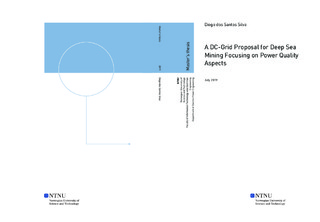| dc.description.abstract | Over the last years, DC grids have become a significant trend topic as a solution for better power distribution systems reducing losses and increasing the efficiency significantly. The technology of HVDC transmission is a reality among wind farms far from land as well as the LVDC grids are under continuous development as an optimum solution for electrical ships reducing fuel consumption drastically.
Looking over these examples of success, the author in this thesis investigates the utilization of a radial DC grid to supply power to typical subsea loads employed by the embryonic, however promising, Deep Sea Mining industry.
The thesis briefly presents the benefits of this technology and appraises the main challenges related to power quality in the DC grids. The issue of harmonic DC currents, in the MVDC transmission, between topside and a subsea converter and in the subsea DC-bus are investigated in this thesis. The converters are connected back to back by a short distance umbilical cable. The focus of the modeling and simulation is, to evaluate the power quality aspects of the interaction between both converters, while the subsea converter maintains a stable DC voltage level for other subsea consumers.
The simulations are performed using the software MATLAB/Simulink. The base case takes into consideration a possible Deep Sea Mining application, where the entire spectrum of possible consumers, such as control systems and motor pumps, are concentrated as a single load fed by a subsea DC-DC converter. This converter shall provide a stable voltage, independently of fluctuations in the power transmission from topside.
The power system is modeled based on the disclosure information published by the company Nautilus Minerals. The subsea consumers are located at a maximum water depth of 3500 meters. However, the power transmission considered is 5000 m, enabling at least 1500 m locomotion to the mining vehicles. A topside converter is responsible for controlling the power to the subsea grid while the subsea converter is responsible for maintaining the voltage in the DC-link stable, assuring a secure operation of the mining vehicles. The results reveal that the line reactances installed upstream the topside converter can eliminate the DC-harmonics at high frequencies in the subsea DC-links while the passive LC filters have a marginal benefit regarding the harmonic reduction in the DC-grid. They also expose that the voltage in the subsea DC-bus can be very stable if the voltage step-down is sufficiently high in the DC-DC converter. | |
